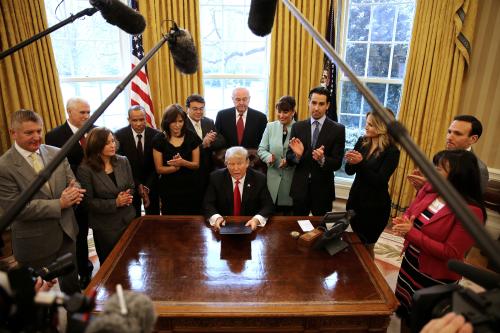On the surface, CBO’s new projections of the federal debt and deficits over the next 10 years paint a troubling picture. But, dig deeper and the story gets … more dire. The Federal government is not only running enormous deficits, but we are doing so at a time of full-employment. When the inevitable recession comes, we will be in deep trouble.
Here’s the bad part: Under current law, CBO projects that the debt—currently 77 percent as large as annual GDP—will rise to 96 percent of GDP by 2028. And that’s if Congress does nothing. If instead, Congress votes to extend expiring tax provisions—such as the many temporary tax cuts in the 2017 tax overhaul—and maintain spending levels enacted in the budget deal (which is called the “current policy” baseline), debt is projected to rise to 105 percent of GDP by 2028, the highest level ever except for one year during World War II (when it was 106 percent).
When the inevitable recession comes, we will be in deep trouble.
After World War II, Federal debt outstanding fell relative to the size of the economy, but no reasonable forecaster would expect that to happen after 2028 absent major policy changes. Under both current law and current policy, Federal budget deficits are projected to rise over the course of the next decade and will continue to be large after 2028. Under current law, Federal deficits average 4.9 percent of GDP and exceed 5 percent of GDP by the end of the decade, higher than any time in the postwar period except one year in the early 1980s and right after the 2007-9 financial crisis and Great Recession. Under current policy, Federal budget deficits are projected to average 5.9 percent of GDP over the decade and exceed 7 percent of GDP in 2028. So, even by a conventional historical comparison of debt and deficits, the prospects look bad.
Here’s the worse part: The conventional comparison is misleading. The projected budget deficits in the coming decade are essentially “full-employment” deficits. This is significant because, while budget deficits can be helpful in recessions by providing an economic stimulus, there are good reasons we should be retrenching during good economic times, including the one we are in now. In fact, CBO projects that, over the 2018-2028 period, actual and potential GDP will be equal. As President Kennedy once said “the time to repair the roof is when the sun is shining.” Instead, we are punching more holes in the fiscal roof.
In order to do an “apples to apples” comparison, we should compare our projected Federal budget deficits to full employment deficits. From 1965-2017, full employment deficits averaged just 2.3 percent of GDP, far lower than either our current deficit or the ones projected for the future.
The fact that debt and deficits are rising under conditions of full employment suggests a deeper underlying fiscal problem.
CBO’s budget projections are a harsh reminder that the fiscal largesse that Congress and the Administration lavished on the country in the recent legislation is not a free lunch.





Commentary
The fiscal picture is worse than it looks—and it looks bad
April 11, 2018